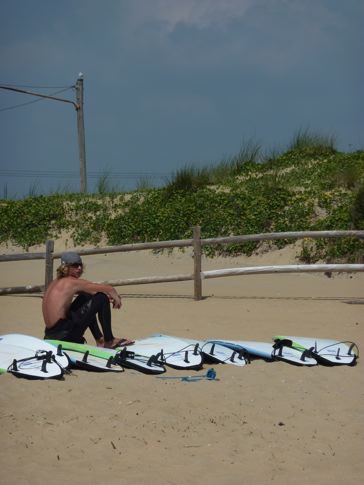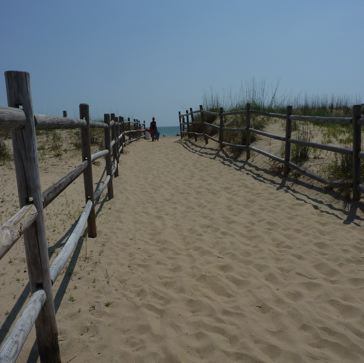 We’ve all watched surfers from our lounge chairs on the beach, as they glide through the water on their board.
We’ve all watched surfers from our lounge chairs on the beach, as they glide through the water on their board.
Some manage to keep their feet firmly planted, body balanced, as they ride the wave through to the end; others end up swallowed by the roiling surf, riding underneath the wave, rather than on top.
Curious to learn how it all works, Lea Hutchins embarked on her own surfing adventure, and shares the lessons she wishes she had known before she got on the board.
I’ve often watched them, wondering what it would be like to skim through the water like that. I know it was part fear, part awe, keeping me from trying it all of these years. I felt safer on the sidelines, with my feet planted firmly in the sand. But a friend, a fellow surfing novice, finally convinced me to join her for surfing lessons.
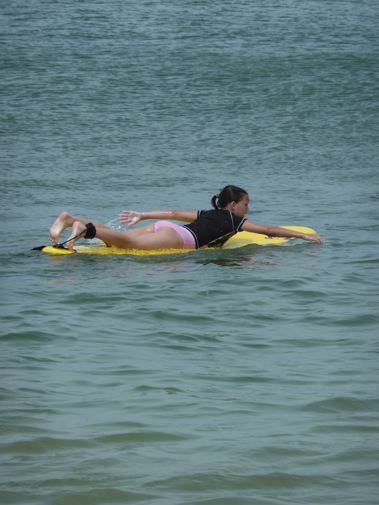 I never thought it would be easy. It wasn’t. I never thought I would have so much fun. I did. But even endless viewings of surfing movies like Point Break and Blue Crush couldn’t fully prepare me for this day. These are five lessons I learned from grabbing that board, and paddling out to meet those waves head on.
I never thought it would be easy. It wasn’t. I never thought I would have so much fun. I did. But even endless viewings of surfing movies like Point Break and Blue Crush couldn’t fully prepare me for this day. These are five lessons I learned from grabbing that board, and paddling out to meet those waves head on.
1) Buy a rash guard
Depending on the time of year and where you’ll be surfing, you may either be provided a wetsuit, or given the opportunity to rent one. If you’ll be hitting the waves in a warm climate, as I was, this will not be necessary. However, I would still strongly recommend purchasing a rash guard for this adventure.
Surfing beginners learn on a soft top (foam) long board, while fiberglass boards rubbed down with wax are used by those that are more experienced.
For more fun in the surf, check out our Water Sports section.
My instructors advised that it was not necessary to use a rash guard when using a soft top board, but after three hours in the water, consistently sliding on and off the board, my stomach took a beating. Having an extra layer between you and the board during that time will very much help reduce any irritation you may acquire from the steady friction, not to mention protect your skin from extensive exposure to the sun.
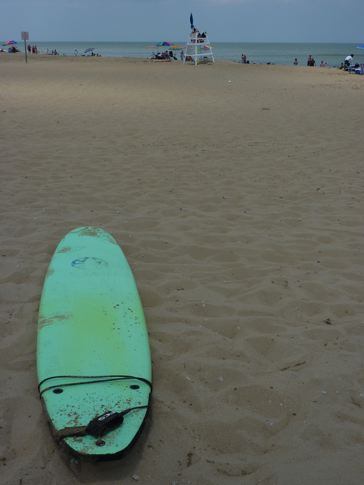 2) Spend time doing more arm and shoulder workouts before trying to surf
2) Spend time doing more arm and shoulder workouts before trying to surf
I saw how much paddling a surfer did out in the water, but for some reason, I always thought that I would need to focus more on legs and balance. I was unbelievably ill-prepared for how much upper body strength it took to even get to the point of standing on the board.
First, you will be pulling yourself back onto your board numerous times after simply sliding off, or making your way back out after catching a wave.
Second, as you lay on your board waiting for that perfect wave, you will be propped up on your arms, trying to stay balanced without tipping over.
And lastly, you will paddle, and paddle, and paddle. You will paddle back out after riding one in, and you will paddle over and over again trying to push yourself into the wave. Sometimes you paddle, but the wave dies out before you get the opportunity to ride it. And sometimes, no matter how hard you paddle, the wave is just faster than you are. Then you must swim back, pull yourself up on the board, balance and wait for the next one.
Find more sun ‘n fun in our Beach Vacations section.
As I quickly learned, surfing takes an extreme amount of endurance. Between the constant paddling and pulling yourself back onto the board, not to mention the adrenaline rush you feel as a wave approaches, you will need a high amount of stamina to keep pushing you back out into the water. Especially if, like me, you do not want to quit until you finally achieve an upright standing position.
4) Spend more time on the beach practicing with the board before hitting the water
One of the most difficult parts of surfing is the “pop up.” This is the action of moving from your prone position on the board, and in one swift motion, pulling your legs under you to bring you to your feet. Our instructors demonstrated this for us, and we practiced on the beach before moving into the water.
Surfing with kids? Try Beyond Disneyland: Family-Friendly Orlando Travel.
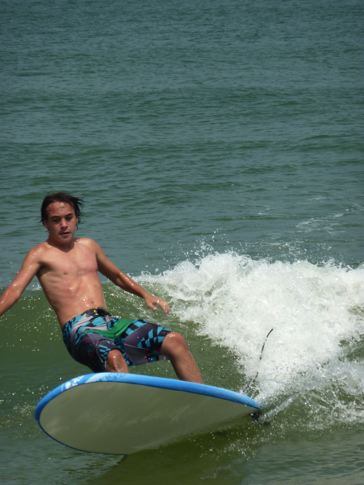 Because the whole point of surfing is to be in an upright standing position on your board when you ride in the wave, this movement is probably the most important task to accomplish. I feel if I had spent more time on the beach mastering this move, I would have had an easier time applying it when I was actually in the water.
Because the whole point of surfing is to be in an upright standing position on your board when you ride in the wave, this movement is probably the most important task to accomplish. I feel if I had spent more time on the beach mastering this move, I would have had an easier time applying it when I was actually in the water.
5) Do not be afraid to fall
This is a very difficult feat for most, but once you come to terms with the fact that yes, you will fall, you will be able to spend more time trying to get up on the board, instead of riding in the waves on your knees because of your fear. Even accomplished surfers end up under the waves instead of on them, and as you are learning, it is extremely likely this will happen.
Embrace it. Prepare for it in your head. Because then, you will spend more time focusing on actually getting to your feet than worrying about what will happen if you don’t make it. It’s all part of the experience.
Text and photos by Lea Hutchins for PeterGreenberg.com.
Related links on PeterGreenberg.com:










